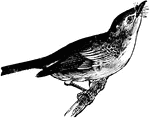
Warbling Vireo
"Similar to V. gilvus, but smaller; colors paler; bill more depressed; upper mandible almost black;…
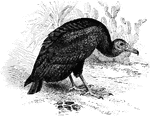
Black Vulture
"Catharista atrata. Black Vulture. Carrion Crow. Adult: Entire plumage, including skin of head, and…
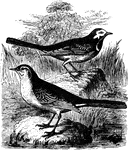
A White and Yellow Wagtail Sitting on the Rocks
A (Motacilla alba) or White Wagtail (upper) and a (Motacilla flava) Yellow Wagtail (lower) sitting on…

Yellow Wagtail Head and Foot
"The Yellow Wagtail or Motilla flava has characters of the Motacilla alva; tail shorter, not exceeding…
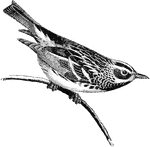
Black and White Warbler
"Mniotilta varia, the Black and White Warbler, The general coloration is olive-green, grey, or slaty-blue,…
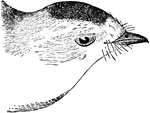
Black-capped Fly-catching Warbler
"Myiodioctes pussies. Blacked-capped Fly-catching Warbler. Upper parts, including exposed edging of…
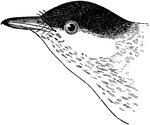
Black -poll Warbler
"Black-poll Warbler or Dendroica striata. Back, rump, tail-coverts grayish-olive, heavily streaked with…
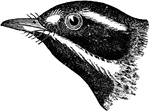
Black-throated Gray Warbler
"Black-throated Gray Warbler or Dendroica nigrescens. Above, bluish-ash, the interscapular region, and…
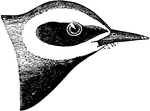
Blue Golden-Winged Warbler
"Blue Golden-Winged Warbler or Helminthophila chrysoptera. Upper parts slaty-blue, or or fine bluish-gray;…
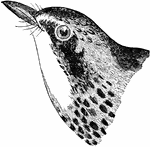
Canada Warbler
"Myiodioctes canadensis. Canadian Fly-catching Warbler. Canada Warbler. Bluish-ash; crown speckled with…
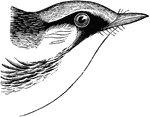
Chestnut-sided Warbler
"Chestnut-sided Warbler, Dendroica pensylvanica. Back streaked with black and pale yellow (sometimes…
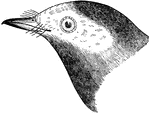
Hooded Warbler
"Myiodioctes mitratus. Hooded Fly-catching Warbler. Hooded Warbler. Clear yellow-olive above; below,…
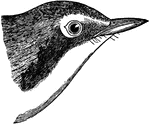
Kentucky Warbler
"Kentucky Warbler. Oporornis formosus. Clear olive-green; entire under parts bright yellow, olive-shaded…

Magnolia Warbler
"Black -and-Yellow Warbler. Magnolia Warbler. Back black, usually quite pure and uninterrupted in the…
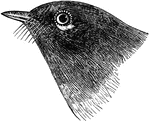
Painted Fly-catching Warbler
"Painted Fly-catching Warbler. Setophaga picta. Painted Redstart. Lustrous black; middle of breast and…

Worm-Eating Warbler
"Worm-Eating Warbler or Helmitheros vermivorus. Olive, below buffy, paler or whitish on the belly; head…

Yellow-rumped Warbler
"Yellow-rumped Warbler or Dendroica coronata. Yellow-crowned Warbler. Myrtle Bird. Slaty-blue, streaked…
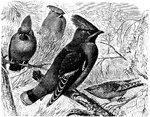
Bohemian Waxwing
"Ampelis garrulus. Bohemian Waxwing. General color brownish-ash, shading insensibly from the clear ash…
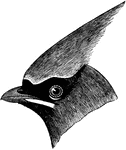
Cedar Waxwing
"Ampelis cedrorum. Cedar Waxwing. Carolina Waxwing. Cedar-bird. Cherry Bird. General color shading from…
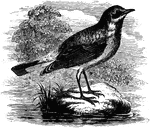
Wheatear
Wheatear male has a bluish-gray back, black patch on ear, a white rump and sides of tail, and black…
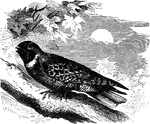
Large Whippoorwill
"Antrostomus vociferus. Whippoorwill. Night-jar. Upper parts variegated with gray, black, whitish, and…

Small Whippoorwill
"Antrostomus vociferus. Whippoorwill. Night-jar. Upper parts variegated with gray, black, whitish, and…
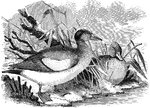
American Wigeon
"Mareca americana. American Wigeon. Bald-pate. Bill grayish-blue, with black tip and extreme base; feet…

Willet Head
"Symphemia semipalmata. Semipalmated Tattler. Willet. Adult in summer: Upper parts ashy, confoundedly…
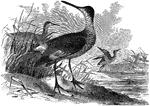
Willets
"Symphemia semipalmata. Semipalmated Tattler. Willet. Adult in summer: Upper parts ashy, confoundedly…

American Woodcock Head
"Philohela. American Woodcock. First three primaries emarginate, attenuate and falcate, abruptly shorter…
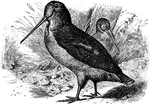
American Woodcock
"Philohela minor. Woodcock. Bog-sucker. Colors above harmoniously blended and varied black, brown, gray,…
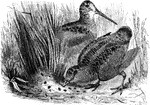
Probing American Woodcock
"Philohela minor. Woodcock. Bog-sucker. Colors above harmoniously blended and varied black, brown, gray,…
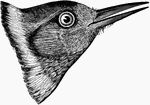
Lewis' Woodpecker Head
"Asyndesmus torquatus. Lewis' Woodpecker. Lared Woodpecker. Adult: Upper parts, including wings and…

Woodpecker Skull
"Saurognathous skull of a nesting Picus minor. x4 diameters, after Parker. Px premaxillary: dpx, its…

Top View of a Woodpecker Skull
"Top view of skull of Cloaptes, (flickers) showing thyrohyals running along the skull and into right…
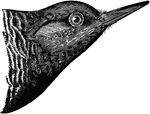
Brown-headed Woodpecker
"Sphyropicus thyroides. Brown-headed Woodpecker. Black-breasted Woodpecker. Red-throated Woodpecker.…
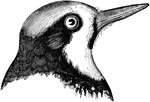
Californian Woodpecker
"Melanerpes formicivorus bairdi. Californian Woodpecker. Glossy blue-black; rump, bases of all the quills,…

Downy Woodpecker
"Picus pubescens. Downy Woodpecker. Usually 6-7 long; outer tail-feathers barred with black and white.…

Hairy Woodpecker
"Picus villosus. Hairy Woodpecker. Spotted and lengthwise streaked, but not banded. Usually 9-10 long;…
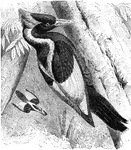
Ivory-billed Woodpecker
"Campephilus principalis. Ivory-billed Woodpecker. Glossy blue-black; a stripe down side of neck, one…
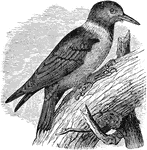
Lewis' Woodpecker
"Asyndesmus torquatus. Lewis' Woodpecker. Lared Woodpecker. Adult: Upper parts, including wings and…
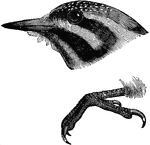
Nuttall's Woodpecker
"Picus scalaris nutalli. Nuttall's Woodpecker. Similar; rather larger' more white, this prevailing on…

Red-bellied Woodpecker
"Centurus carolinus. Red-bellied Woodpecker. Whole crown and nape scarlet in the male; nape only so…
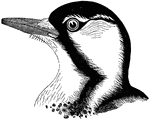
Red-cockaded Woodpecker
"Picus borealis. Red-Cockaded Woodpecker. Body spotted and crosswise banded, but not streaked. Head…

Red-headed Woodpecker
"Melanerpes erythrocephalus. Red-headed Woodpecker. Tricolor. Adult: Beautifully tricolor with "the…
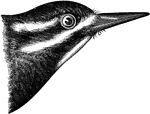
Red-headed Woodpecker
"Sphyropicus thyroides. Brown-headed Woodpecker. Black-breasted Woodpecker. Red-throated Woodpecker.…
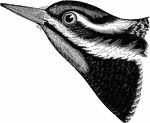
Yellow-bellied Woodpecker
"Sphyropicus varius. Yellow-bellied Woodpecker. Male: Crown crimson, bordered all around with black;…
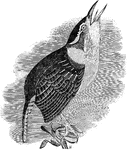
Carolina Wren
"Carolina Wren. Upper parts uniform reddish-brown, brightest on the rump, where are concealed whitish…
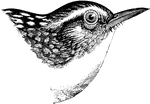
Long-billed Marsh Wren
"Long-billed Marsh Wren. T. palustris. Above clear brown, unbarred, the middle of the back with a large…

Rock Wren
"Upper parts pale brownish-gray, minutely dotted with blackish and whitish points together, and usually…

Short-billed Marsh Wren
"Short-billed Marsh Wren. Cistothorus platensis. Upper parts brown, the crown and most of the back blackish,…

Winter Wren
"Winter Wren. Above brown, darker before, brighter behind, most of back, together with tail and inner…

Greater Yello-shanks
"Totanus melanoleucus. Greater Tell-tale. Greater Yellow-shanks. Long-legged Tattler. Stone-snipe. Bill…
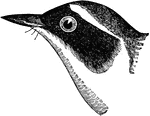
Common Yellowthroat
"Geothlypis trichas. Common Yellowthroat. Yellow-throated Ground Warbler. Maryland Yellow-throat. Upper…